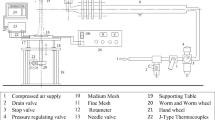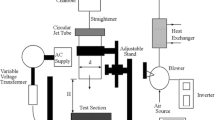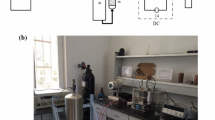Abstract
The effects of micro-pin characteristics on flow and heat transfer of a circular impinging jet are studied both experimentally and numerically. The studies are carried out for a single jet impinging (D = 24 mm) on a target plate that roughened by 48 micro-pins. The target surface is heated by a silicon rubber heater under a uniform heat flux of 2000 W m−2. Two Re numbers (20,000 and 40,000), three distances between the pins and the jet (S/D = 1, S/D = 2, S/D = 3) and three nozzle-to-surface distance ratios (0.5, 1 and 2) are considered. Experimental and numerical results confirm that using micro-pin on the target surface has a significant effect on the distributions of Nusselt number. In addition, the results show that using the micro-pin on the target plate may result in both decrease and increase in the averaged Nusselt number depending on the arrangement of the micro-pins. For the Reynolds number of 40,000, the presence of the micro-pins at S/D = 2.0 can increase the average Nusselt number by 10.8%, 10.1% and 11% at H/D = 0.5, 1.0 and 2.0, respectively.











Similar content being viewed by others
Abbreviations
- C p :
-
Specific heat (N m kg−1 K−1)
- d :
-
Pin diameter (mm)
- D :
-
Nozzle diameter (mm)
- H :
-
Nozzle-to-surface spacing (mm)
- k :
-
Turbulence kinetic energy (m2 s−2)
- Nu:
-
Local Nusselt number
- P :
-
Static pressure (Pa)
- q″:
-
Heat flux (W m−2)
- Re:
-
Reynolds number
- S :
-
The distance of pins to impingement point
- R :
-
The target plate radius
- T :
-
Temperature (K)
- u :
-
Velocity (m s−1)
- X :
-
Coordinates (x, y, s)
- y + :
-
Dimensionless distance
- ε :
-
Turbulent dissipation rate (m2 s−3)
- k :
-
Turbulent kinetic energy (m2 s−2)
- μ :
-
Dynamic viscosity (N s m−2)
- ρ :
-
Density (kg m−3)
References
Hong SK, Lee DH, Rhee DH, Cho HH. Local heat/mass transfer measurements on effusion plates in impingement/effusion cooling with rotation. Int J Heat Mass Transf. 2010;53(7):1373–9.
Hadipour A, Rajabi-Zargarabadi M. Heat transfer and flow characteristics of impinging jet on a concave surface at small nozzle to surface distances. Appl Therm Eng. 2018;138:534–41.
Rajabi Zargarabadi M, Rezaei E, Yousefi-Lafouraki B. Numerical analysis of turbulent flow and heat transfer of sinusoidal pulsed jet impinging on an asymmetrical concave surface. Appl Therm Eng. 2018;128:578–85.
Mohammadpour J, Rajabi-Zargarabadi M, Mujumdar AS, Ahmadi H. Effect of intermittent and sinusoidal pulsed flows on impingement heat transfer from a concave surface. Int J Therm Sci. 2014;76:118–27.
Wan C, Rao Y, Zhang X. Numerical investigation of impingement heat transfer on a flat and square pin-fin roughened plates. In: ASME paper GT2013-94473 (2013).
Spring S, Xing Y, Weigand B. An experimental and numerical study of heat transfer from arrays of impinging jets with surface ribs. ASME J Heat Transf. 2012;134(8):082201.
Ming T, Cai C, Yang W, Shen W, Gan T. Optimization of dimples in microchannel heat sink with impinging jets—part A: mathematical model and the influence of dimple radius. J Therm Sci. 2018;27(3):195–202.
Ming T, Cai C, Yang W, Shen W, Feng W, Zhou N. Optimization of dimples in microchannel heat sink with impinging jets—part B: the influences of dimple height and arrangement. J Therm Sci. 2018;27(4):1–10.
Huang X, Yang W, Ming T, Shen W, Yu X. Heat transfer enhancement on a microchannel heat sink with impinging jets and dimples. Int J Heat Mass Transf. 2017;112:113–24.
Teuscher KL, Ramadhyani S, Incropera FP. Jet impingement cooling of an array of discrete heat sources with extended surfaces. Enhanc Cool Tech Electron Appl HTD. 1993;263:1–10.
Xie GN, Sundén B, Zhang WH. Comparisons of pins/dimples/protrusions cooling concepts for a turbine blade tip-wall at high Reynolds numbers. J Heat Transf. 2011;133(6):061902.
Umair SM, Gulhane NP. On numerical investigation of heat transfer augmentation through pin fin heat sink by laterally impinging air jet. Proc Eng. 2016;157:89–97.
Varun RP, Saini SK. Singal, Investigation of thermal performance of solar air heater having roughness element as a combination of inclined and transverse ribs on the absorber plate. Renew Energy. 2008;33(6):1398–405.
Xie Y, Shi D, Shen Z. Experimental and numerical investigation of heat transfer and friction performance for turbine blade tip cap with combined pin-fin-dimple/protrusion structure. Int J Heat Mass Transf. 2017;104:1120–34.
Brakmann R, Chen L, Weigand B, Crawford M. Experimental and numerical heat transfer investigation of an impinging jet array on a target plate roughened by cubic micro pin fins. J Turbomach. 2016;138(11):111010.
Kim SH, Ahn KH, Park JS, Jung EY, Hwang KY, Cho HH. Local heat and mass transfer measurements for multi-layered impingement/effusion cooling: effects of pin spacing on the impingement and effusion plate. Int J Heat Mass Transf. 2017;105:712–22.
Trabold TA, Obot NT. Impingement heat transfer within arrays of circular jets: part II—effects of crossflow in the presence of roughness elements. J Turbomach. 1987;109(4):594–601.
Ndao S, Lee HJ, Peles Y, Jensen MK. Heat transfer enhancement from micro pin fins subjected to an impinging jet. Int J Heat Mass Transf. 2012;55(1–3):413–21.
Wan C, Rao Y, Chen P. Numerical predictions of jet impingement heat transfer on square pin-fin roughened plates. Appl Therm Eng. 2015;80:301–9.
Quan D, Liu S, Li J, Liu G. Investigation on cooling performance of impingement cooling devices combined with pins. In: ASME turbo expo, pp 793–799 (2005).
Son C, Dailey G, Ireland P, Gillespie D. An investigation of the application of roughness elements to enhance heat transfer in an impingement cooling system. In: ASME GT2005e68504.
Yamawaki S, Nakamata C, Imai R, Matsuno S, Yoshida T, Mimura F, Kumada M. Cooling performance of an integrated impingement and pin fin cooling configuration. In: ASME GT2003e38215.
Azad GS, Huang Y, Han JC. Jet impingement heat transfer on pinned surfaces using a transient liquid crystal technique. J Thermophys Heat Transf. 2000;14(2):186–93.
Chyu MK. Heat transfer and pressure drop for short pin-fin arrays with pin endwall fillet. ASME J Heat Transf. 1990;112:926–32.
Chyu MK, Hsing YC, Shih TIP, Natarajan V. Heat transfer contributions of pins and endwall in pin-fin arrays: effects of thermal boundary condition modeling. ASME J Turbomach. 1999;121:257–63.
Sharif MAR, Mothe KK. Parametric study of turbulent slot-jet impingement heat transfer from concave cylindrical surfaces. Int J Therm Sci. 2010;49:428–42.
Hong SK, Rhee DH, Cho HH. Heat/mass transfer with circular pin fins in impingement/effusion cooling system with crossflow. AIAA J Thermophys Heat Transf. 2006;20(4):728–37.
Xing Y, Spring S, Weigand B. Experimental and numerical investigation of impingement heat transfer on a flat and micro-rib roughened plate with different crossflow schemes. Int J Therm Sci. 2011;50:1293–307.
Kline SJ, McClintock FA. Describing uncertainties in single-sample experiments. J Mech Eng. 1953;75:3–8.
Latimer BR, Pollard A. Comparison of pressure-velocity coupling solution algorithms. Numer Heat Transf. 1985;8(6):635–52.
Yakhot V, Orszag SA. Development of turbulence models for shear flows by double expansion technique. J Phys Fluid. 1991;4:1510–20.
Menter FR. Two equation eddy-viscosity turbulence models for engineering application. AIAA J. 1994;32(8):269–89.
Lee JLSJ. Stagnation region heat transfer of a turbulent axisymmetric jet impingement. Exp Heat Transf. 1999;12(2):137–56.
Fénot M, Vullierme JJ, Dorignac E. Local heat transfer due to several configurations of circular air jets impinging on a flat plate with and without semi-confinement. Int J Therm Sci. 2005;44(7):665–75.
Author information
Authors and Affiliations
Corresponding author
Additional information
Publisher's Note
Springer Nature remains neutral with regard to jurisdictional claims in published maps and institutional affiliations.
Rights and permissions
About this article
Cite this article
Hadipour, A., Rajabi Zargarabadi, M. & Dehghan, M. Effect of micro-pin characteristics on flow and heat transfer by a circular jet impinging to the flat surface. J Therm Anal Calorim 140, 943–951 (2020). https://doi.org/10.1007/s10973-019-09232-2
Received:
Accepted:
Published:
Issue Date:
DOI: https://doi.org/10.1007/s10973-019-09232-2




